Hang Clean High Pull: How To, Benefits & Variations
Author:
Unlock your full potential by engaging with our experts and community! Have questions about your fitness journey or looking for expert advice on weightlifting techniques? Don’t hesitate — leave a comment below and Oleksiy Torokhtiy will provide a personalized answer and insights to help you reach your goals.
Torokhtiy is reader-supported. Some links are affiliate links, and we may earn a commission at no extra cost to you. See our disclosure page for details.
Hang clean high pull… It’s a mouthful but that’s because this isn’t just your regular exercise. It combines elements of weightlifting and strength training in one and it’s excellent for building explosive strength and improving your fitness in general.
We’ll explain everything you need to know about it – how to do it, why do it in the first place, and how to make things interesting with some variations and alternatives.
Grab a barbell and let’s go!
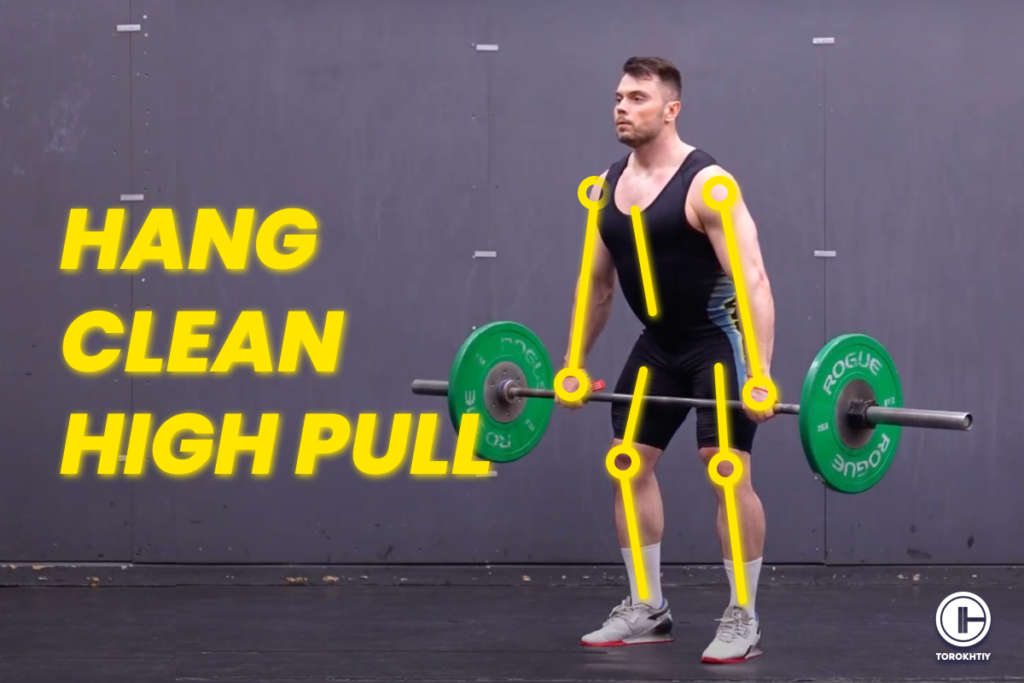
What Is the Hang Clean High Pull?
First off – the basics. You want to know exactly what it is and we’re here for it.
This is a dynamic exercise that starts with you holding the barbell around the knee height (this is called the hang position) and from there, you explosively pull it up to your chin using your hips and legs as a source of power. So, you generate the force in your lower body and transfer it into a strong pull with your upper body.
Sounds like a lot? It’s not if you have a detailed step-by-step explanation on how to do it, which is what’s next!
How to Do the Hang Clean High Pull?
Now that you kind of have an idea of what to expect, let’s see how to do this powerhouse exercise!
1. Setup
You’ll stand with feet hip-width apart and the toes pointed out a little. Hold the barbell about fist width from your thighs, overhand/hook grip and have it rest mid-thigh..
2. Starting Position
Get yourself there by lowering the barbell to just above your knees (high hang) or just below the knees (low hang) by pushing your hips back. Keep your back straight and your core engaged.
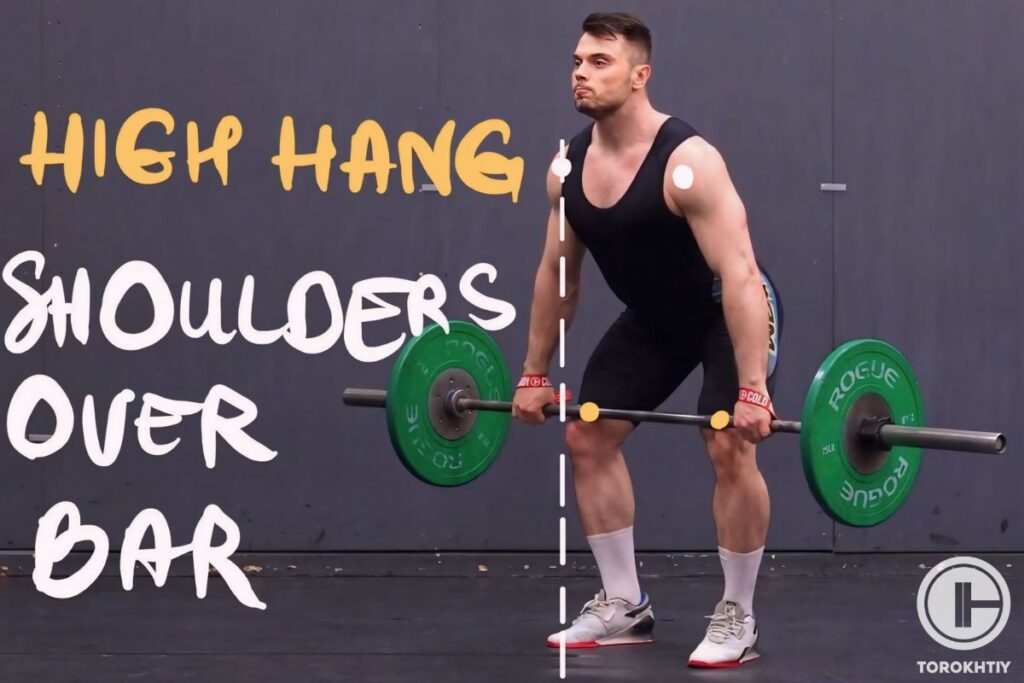
3. Second Pull and Power Position
We will skip the first pull phase as you don’t lift the bar from the floor.
You go into the second pull – Extend your hips, knees and ankles and drive through your midfoot.
This movement transfers the power from your lower body to the bar and prepares you for the shrug and pull.
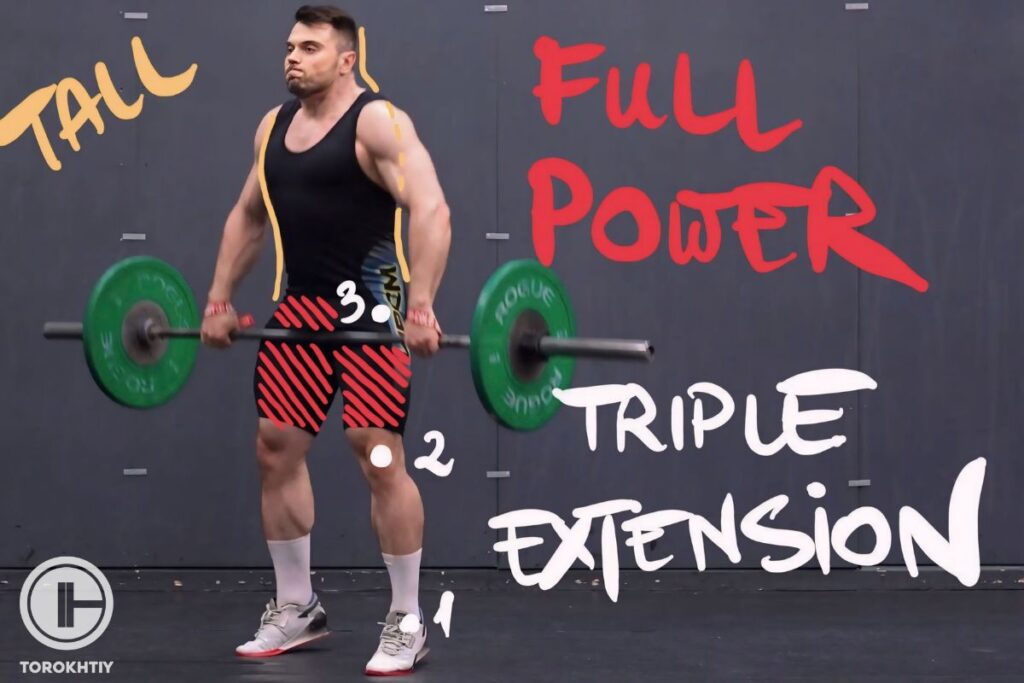
4. Shrug and Pull
As your hips get completely extended, quickly shrug your shoulders back and up. This will add some extra force but mainly arms will determine the trajectory of the bar.
Bend your elbows and continue pulling the bar up. Keep the elbows high and outside.
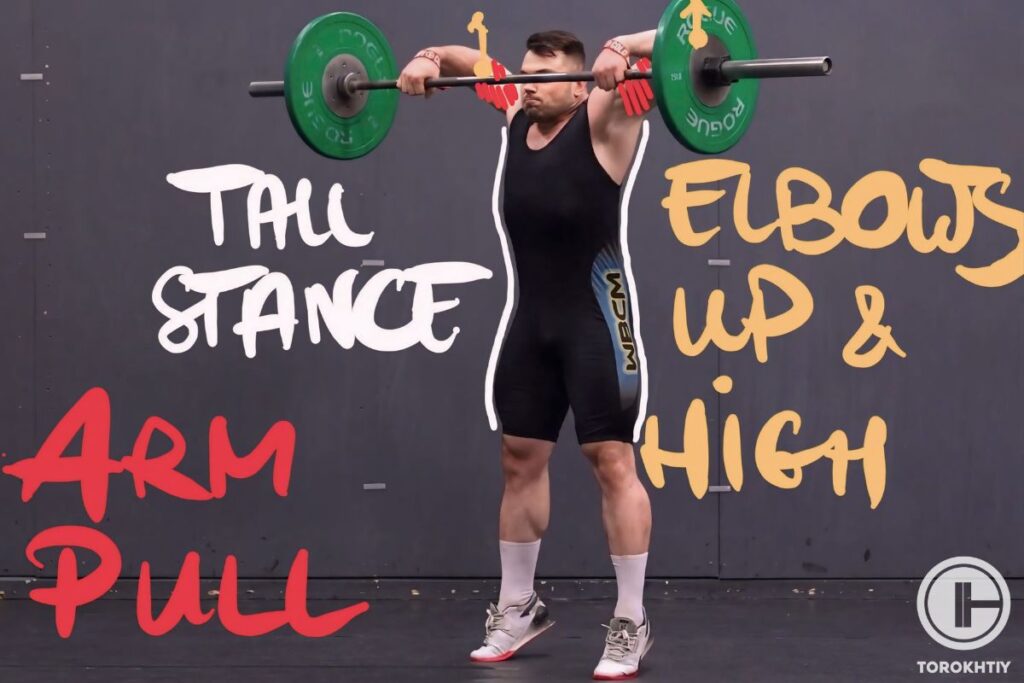
5. Final Position
If you did everything the way you were supposed to, the barbell should rise to about chest level or a bit higher, depending on how much force you generated. Keep your elbows higher than the wrists throughout the pull.
At the peak of the movement, your body should be totally extended, standing on your toes with your shoulders shrugged and elbows high.
Lower the Barbell
This is all about control! You want to lower the barbell back carefully. Extend your elbows and return your shoulders to a neutral position. When the bar gets to just above your knees, you’re ready for the next rep.
And that’s it!
Save it for easy access!
Bookmark this page now to access the program and instructional videos anytime, anywhere.
Stop wasting time searching during your gym sessions.
How to Program Hang Clean High Pull?
Follow our tips and you’ll have absolutely no issues with including the hang clean high pull into your routine. Oh, and don’t forget about rest days to let your muscles recover!
| Level | Reps | Sets | Frequency |
|---|---|---|---|
| Beginner | 8-12 | 3-4 | 2-3 times per week, with at least 1 rest day in between sessions |
| Intermediate | 6-8 | 4-5 | 3-4 times per week |
| Advanced | 3-5 | 4 | 1-5 times per week |
Beginner
- Sets: 3-4 sets
- Reps: 8-12 reps per set
- Frequency: 2-3 times per week, with at least 1 rest day in between sessions
- Progression: Use either just the bar or a very, very light weights because your priority is mastering the form. Increase the weight in 5-10 pounds increments as you progress.
Intermediate
- Sets: 4-5 sets
- Reps: 6-8 reps per set
- Frequency: 3-4 times per week
- Progression: Keep increasing the weight over time and experiment with different grip widths and stances to challenge your muscles in a new way.
Advanced
- Sets: 4 sets
- Reps: 3-5 reps per set
- Frequency: 1-5 times per week
- Progression: You want to focus in addressing your specific limiting factors, whether they’re related to strength, power, technique, etc. Adjust the weight according to the force-velocity curve to optimize power output and emphasize speed during the second pull phase.
Follow us!

Free!
Get a 2-week Weightlifting Program as a bonus for the subscription to kickstart your training plan!

Free!
3 Common Hang Clean High Pull Mistakes
You know you need to warm up before and cool down after your workout, right? If you don’t, you don’t prepare your muscles for what’s ahead and your recovery isn’t as effective.
Apart from this, there are some other mistakes you can make.
Tips From the Champ
Focus on maintaining a straight bar path and keep the bar close to your body throughout the movement. Engage your lats to control the bar’s trajectory, and ensure full hip extension to maximize power and efficiency in the pull.
Olympic Weightlifting Champion
❌ Starting Too Heavy
You might be tempted to lift more weight than you can handle, but you risk getting seriously injured if you do. Proper form keeps you safe and makes whatever you’re doing effective, so until you master it, steer clear of heavy weights.
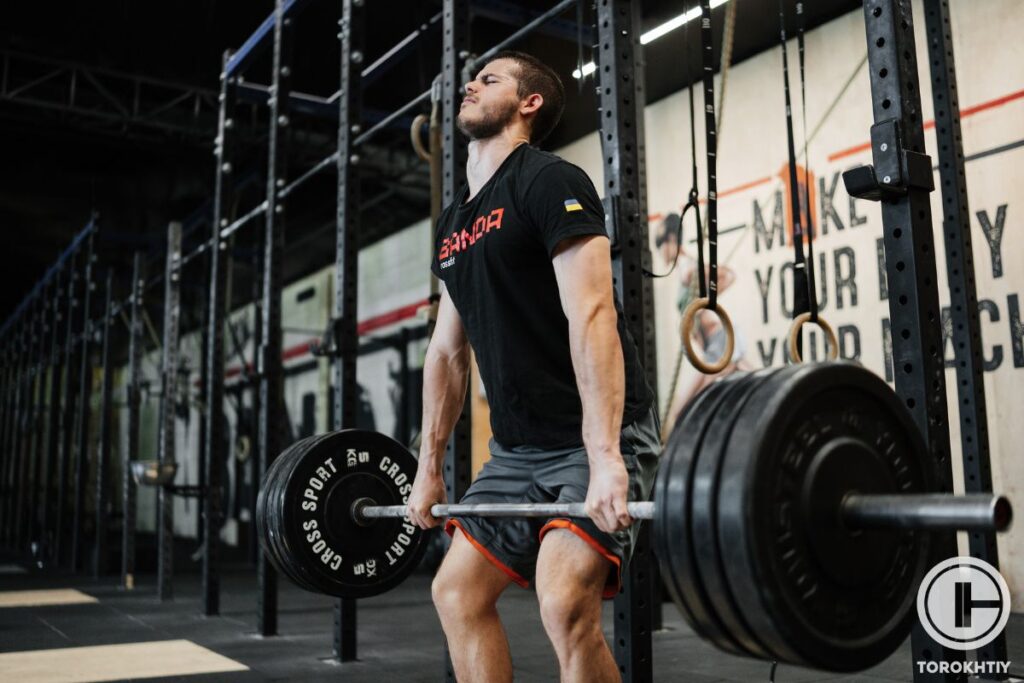
❌ Improper Foot Positioning
If your feet positioning is off (meaning, too narrow or too wide),l it will mess with your balance and stability during the lift. You need to make sure your feet are hip-width apart with your toes slightly out. This gives you a solid base and allows for efficient force transfer.
❌ Barbell Drifting Away from the Body
You need to keep the barbell close to your body. If it drifts away, it will strain your lower back and it will make the lift less effective than it should be.
3 Benefits of Hang Clean High Pull
There’s a ton of benefits to this exercise, let’s go over the main ones!
✅ Explosive Power
If you do it on a regular basis, the hang clean high pull can help you be able to generate force quickly, and that’s important for things like sprinting, jumping, and sports that rely on explosive movements.
✅ Better Coordination and Technique
If you’ve ever done it, you know this exercise needs a lot of coordination between your lower and upper body, so if you’re consistent, it will improve your motor skills and movement efficiency.
✅ Improved Bone Density
Weight-bearing exercises will do wonders for bone density and prevention of osteoporosis and hang clean high-pull is one of these exercises.
3 Hang Clean High Pull Variations
Wanna spice up your routine even further? That’s what variations are for!
1. Low Hang Clean High Pull
It starts with the barbell just below the knees and it emphasizes a greater range of motion. This will help you build strength and power in your lower body.
2. High Hang Clean Pull
You start with the barbell positioned at the upper thigh and focus on generating explosive power through a shorter range of motion. This variation is excellent for developing quick, explosive movements.
3. High Pull from Blocks
There is no hang phase really but it can be a valuable option. Elevate the bar to a higher position (like blocks or pins) to reduce the range of motion. This one focuses on explosiveness and it’s good for people who want to work on specific portions of the lift.
3 Hang Clean Pull Alternatives
There are some great alternatives to the hang clean pull that can give you the same benefits. Along with variations, alternatives are another excellent way to freshen up your routine.
1. High Pull
The high pull mostly focuses on the pulling phase and it starts from either the floor or a hang position. It’s great for targeting the upper back, shoulders, and traps.
2. Snatch (high) Pull
Snatch High-Pull is the same exercise but the difference is in a grip width – You do it with your regular Snatch grip.
3. Sumo Deadlift High Pull
This exercise focuses on similar muscle groups and movement patterns as the hang clean high pull. You start with a wide stance and the barbell on the ground. Grip the bar and do a deadlift. As the bar gets to mid-thigh, pull it up explosively by shrugging your shoulders and bending your elbows. Finish with the bar at chest height.
Who Should Do the Hang Clean High Pull?
Since it’s versatile, many people will benefit from it, but it’s particularly good for some of them.
1. Strength & Power Athletes
People who are focusing on strength and power (like weightlifters and powerlifters) can use the hang clean high pull to improve their lifts, explosiveness, and muscular development in general.
2. People Who Are After Muscle Hypertrophy
If you want to improve the size and definition of your muscles, this is an exercise you’ll love because it targets major muscle groups and, with the right programming, promotes muscle growth.
3. Beginners
This is a great exercise for beginner lifters because it teaches basic explosive movements and proper hip hinge mechanics. If you’re a beginner athlete, it will help your athletic performance because the hang clean high pull enhances hip extension and power transfer.
Beginners in general fitness can expect to develop full-body strength with the hang clean high pull, as well as conditioning.
Muscles Worked by the Hang Clean High Pull
Mostly, the focus is on the posterior chain, which includes your upper back, shoulders, and traps.
The initial pull phase engages your glutes, hamstrings, and lower back to generate power and drive the bar up. As the bar gets to the high pull phase, the upper back and shoulders are activated to pull it towards your chest or lower neck.
The core keeps you stable the entire time and the arms and grip control the bar’s trajectory.
Conclusion
And that’s it – you know everything you could possibly want to know on this subject. And, hey, if you get bored of the hang clean high pulls, give those variations and alternatives a whirl. We promise they won’t disappoint you.
What are your thoughts on this? Have you tried it already? If you haven’t, what’s stopping you? What’s the alternative/ variation you’re most excited to try?
We’d love to know your thoughts, so leave a comment and then go work out!
Also Read:
- Snatch vs Clean & Jerk
- Hang Clean Pull
- Clean and Press
- CLEAN & JERK
- Clean Pull
- Clean Warm Up: Best Exercises & Routine Example
- Power Clean
- Hang Power Clean: Technique, Benefits & Common Mistakes
References:
- Becks Shepherd “Why are rest days important?” LiveScience, https://www.livescience.com/why-are-rest-days-important (accessed June 12th, 2024)
- Hyoung-Kil Park, Min-Kyung Jung, Eunkyung Park, Chang-Young Lee, Yong-Seok Jee, Denny Eun, Jun-Youl Cha, and Jaehyun Yoo. “The effect of warm-ups with stretching on the isokinetic moments of collegiate men.” Journal of Exercise Rehabilitation 14, no. 1 (2018): 78–82.
- Stacey Carter “Why it’s important to cool down after exercise, according to the science,” LiveScience, https://www.livescience.com/why-its-important-to-cool-down-after-exercise-according-to-the-science (accessed June 11th, 2024)
- “Slowing bone loss with weight-bearing exercise,” Harvard Health Publishing, https://www.health.harvard.edu/staying-healthy/slowing-bone-loss-with-weight-bearing-exercise (accessed June 11th, 2024)
- “Prevention Osteoporosis,” National Health Service, https://www.nhs.uk/conditions/osteoporosis/prevention/ (accessed June 12th,2024)
- Photos by Torokhtiy Media Team.
Why Trust Us?
With over 20 years in Olympic weightlifting, strength training, nutrition coaching, and general fitness our team does its best to provide the audience with ultimate support and meet the needs and requirements of advanced athletes and professional lifters, as well as people who strive to open new opportunities and develop their physical capabilities with us.
By trusting the recommendations of our certified experts in coaching, nutrition, and sports training programming, as well as scientific consultants, and physiotherapists, we provide you with thorough, well-considered, and scientifically proven content. All the information given in the articles concerning workout programming, separate exercises, and athletic performance, in general, is based on verified data.
The product testing process is described in more detail here.
Author: Oleksiy Torokhtiy
Olympic Weightlifting Champion
Best Results: Snatch – 200 kg,
C&J – 240 kg
Oleksiy Torokhtiy is a professional athlete boasting 20 years of experience in Olympic weightlifting. With multiple European and World titles under his belt, he has showcased his prowess in two Olympic Games (Beijing 2008 and London 2012). Upon concluding his illustrious career, Oleksiy dedicated himself to coaching. By 2022, he had conducted over 200 weightlifting seminars worldwide. He is the visionary behind an international sportswear and accessories brand known for its motto, “Warm Body Cold Mind.” Additionally, he is an esteemed author and the creator of a series of training programs and eBooks.
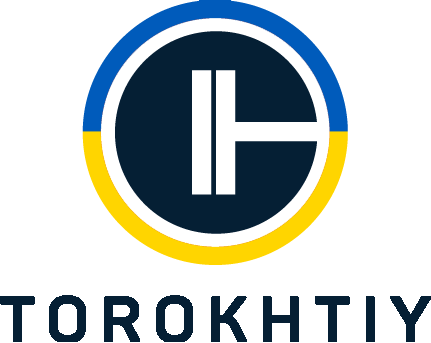



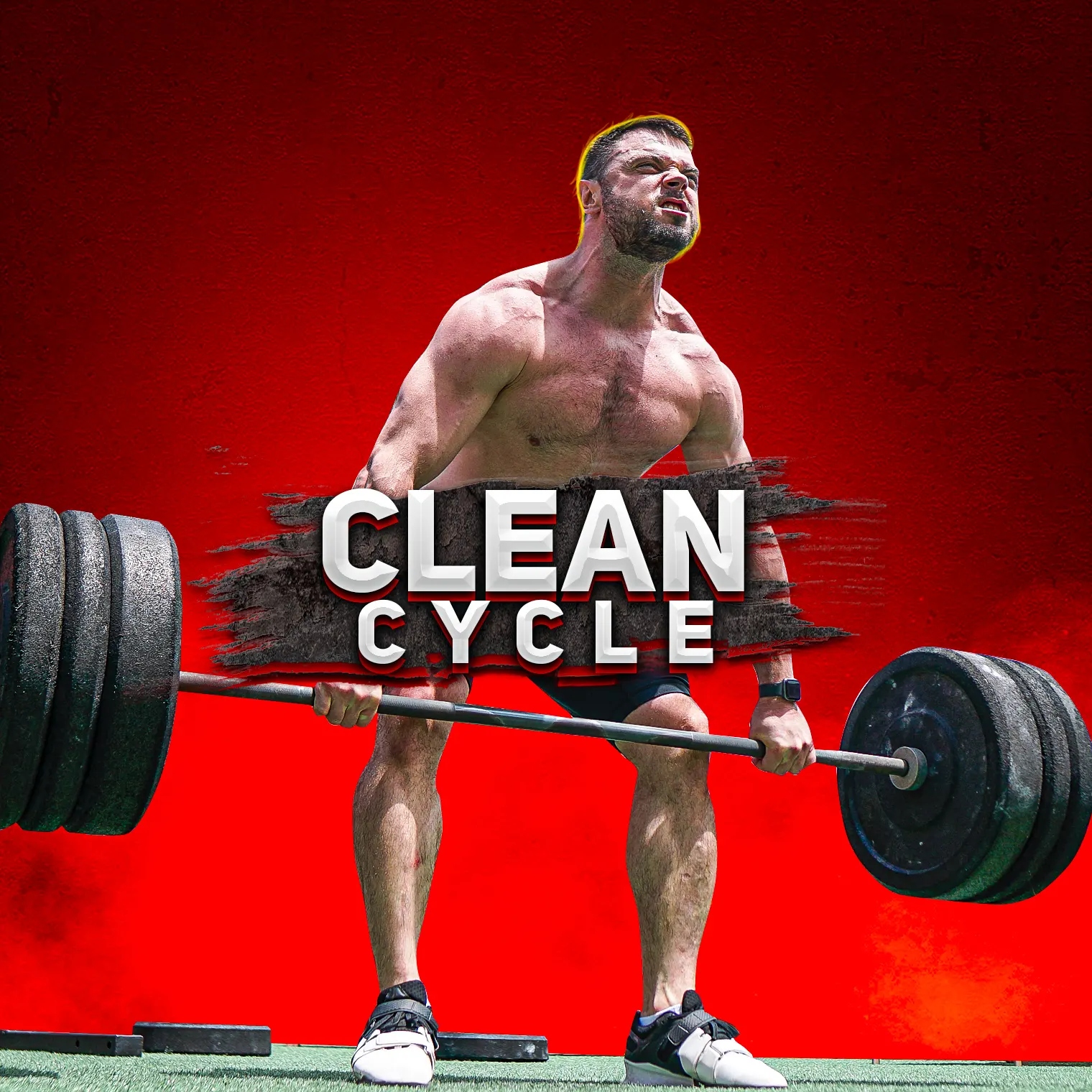
Still have questions after reading our article? Unlock your full potential by engaging with our experts and community! Don’t hesitate — leave a comment below and Oleksiy Torokhtiy will provide a personalized answer and insights to help you reach your goals.